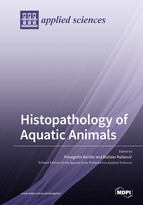Histopathology of Aquatic Animals
A special issue of Applied Sciences (ISSN 2076-3417). This special issue belongs to the section "Applied Biosciences and Bioengineering".
Deadline for manuscript submissions: closed (10 December 2021) | Viewed by 32377
Special Issue Editors
Interests: light and electron microscopy; aquatic animal histology; aquatic animal histopathology; bone mechanical properties; collagen; aquaculture
Special Issues, Collections and Topics in MDPI journals
2. Institute of Animal Science, Faculty of Agriculture,University of Belgrade, Belgrade, Serbia
Interests: fish histology and histopathology; fish ecotoxicology and toxicology; light and electron microscopy; aquaculture
Special Issue Information
Dear Colleagues,
Histopathological studies of aquatic animals refer to the microscopic examination of tissues and organs in order to detect deviations from the expected microscopic or macroscopic structure. Information obtained from the study of histomorphological lesions in aquatic animals can be a useful addition when determining the general state of health of aquatic animals, especially if chronic stressors and/or pathogens are present. Compared to mammals, postmortem autolysis progresses very rapidly in most aquatic organisms. This fact makes the histopathological examination quite complex and demanding, not only in a histotechnical sense. A prerequisite for a successful study is the baseline knowledge of physiological processes and histological architecture of the studied species. Therefore, the aim of this Special Issue is to contribute to the current state of knowledge on the histopathology of aquatic animals and to provide a professional and encyclopedic tool for biologists and veterinarians.
Dr. Panagiotis Berillis
Dr. Božidar Rašković
Guest Editors
Manuscript Submission Information
Manuscripts should be submitted online at www.mdpi.com by registering and logging in to this website. Once you are registered, click here to go to the submission form. Manuscripts can be submitted until the deadline. All submissions that pass pre-check are peer-reviewed. Accepted papers will be published continuously in the journal (as soon as accepted) and will be listed together on the special issue website. Research articles, review articles as well as short communications are invited. For planned papers, a title and short abstract (about 100 words) can be sent to the Editorial Office for announcement on this website.
Submitted manuscripts should not have been published previously, nor be under consideration for publication elsewhere (except conference proceedings papers). All manuscripts are thoroughly refereed through a single-blind peer-review process. A guide for authors and other relevant information for submission of manuscripts is available on the Instructions for Authors page. Applied Sciences is an international peer-reviewed open access semimonthly journal published by MDPI.
Please visit the Instructions for Authors page before submitting a manuscript. The Article Processing Charge (APC) for publication in this open access journal is 2400 CHF (Swiss Francs). Submitted papers should be well formatted and use good English. Authors may use MDPI's English editing service prior to publication or during author revisions.
Keywords
- fish
- histology
- histopathology
- aquatic animals
- histomorphological lesions
- aquaculture
- fisheries
- ecotoxicology
- malformations







